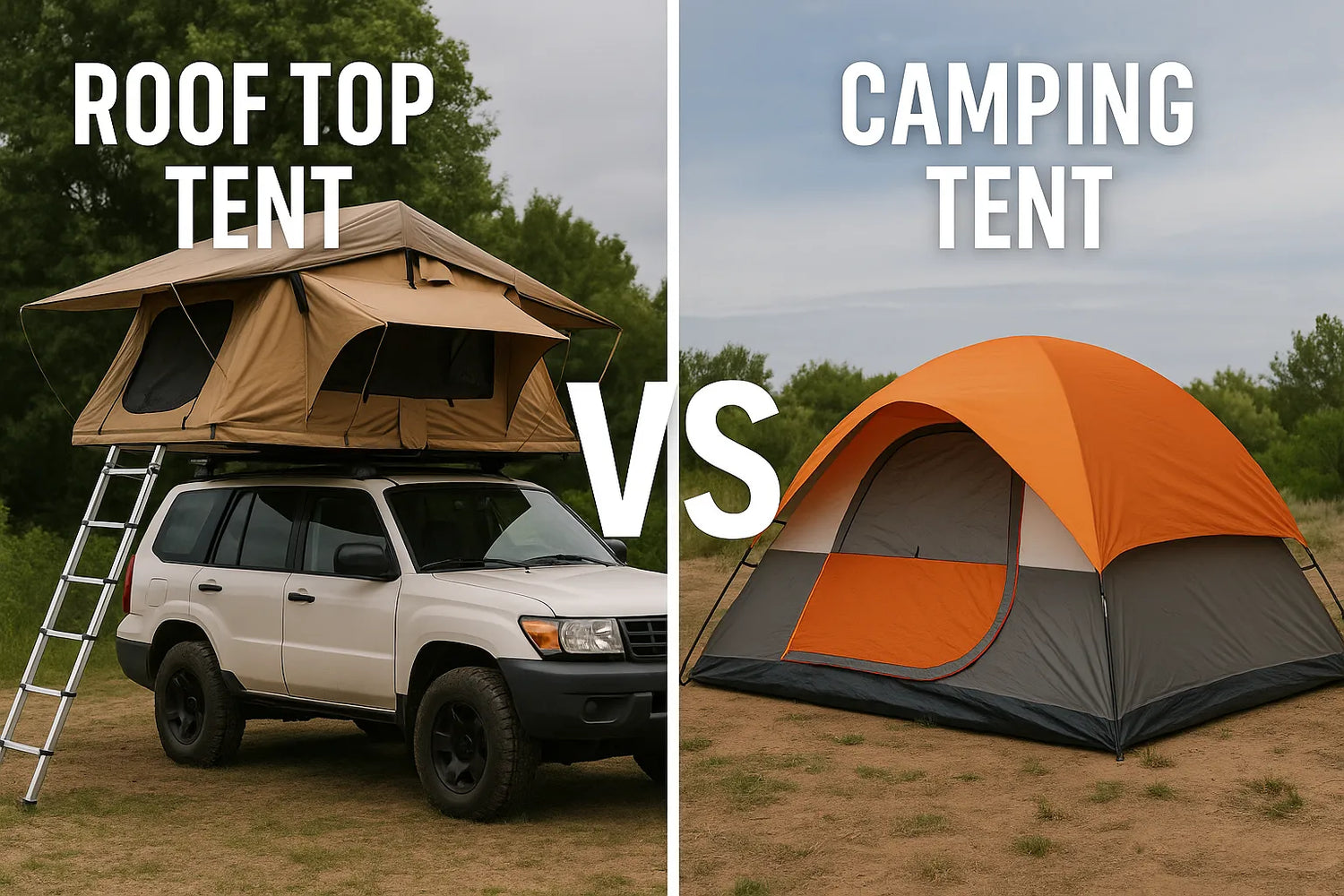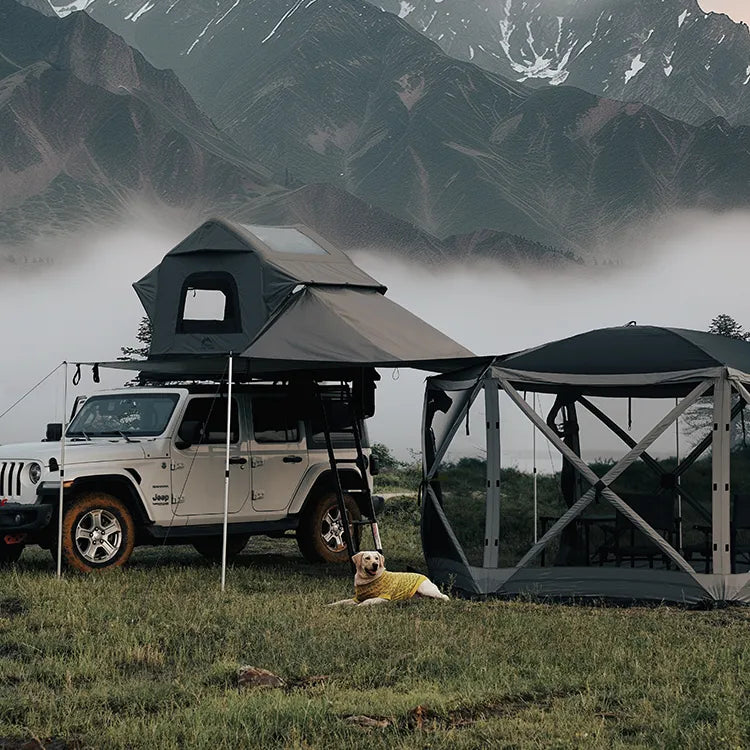Understanding the Basics
What is a Roof Top Tent?
A roof top tent (RTT) is a foldable tent mounted on your vehicle’s roof rack. First gaining traction in Australia and Africa for rugged terrain use, these tents now dominate the overlanding scene in the U.S. and Europe.
Key features:
- Elevated sleeping platform
- Built-in mattress
- Hard shell or soft shell cover
- Ladder access
- Quick setup (usually under 5 minutes)
Roof top tents are ideal for travelers who don’t want to sleep on the cold, uneven ground or deal with traditional tent stakes.
What is a Camping Tent?
The classic camping tent is your portable home away from home. It’s pitched on the ground and comes in various designs: dome, cabin, tunnel, and pop-up styles.
Key features:
- Lightweight and compact
- Available for solo or family use
- Requires flat ground for setup
- More affordable than RTTs
- Wide availability in sporting goods stores
These tents cater to a broader range of campers—from solo hikers to large families.
Roof Top Tent vs Camping Tent: Key Differences
Setup Time & Convenience
Roof Top Tent:
- Pops open in minutes
- Pre-installed mattress = no sleeping pad setup
- Requires ladder positioning
Camping Tent:
- Takes 10–20 minutes depending on size
- Involves laying out ground tarp, poles, and rainfly
- Needs extra bedding and airflow prep
Verdict: RTTs win for speed and ease, especially in unpredictable weather.
Comfort and Sleeping Experience
- RTTs provide a level, elevated surface with thick foam mattresses.
- Camping tents require additional sleeping gear and are susceptible to uneven terrain.
Many users report better sleep quality in RTTs due to elevation, built-in padding, and less ground moisture.
Weather Resistance
Roof Top Tents:
- Built to handle wind, rain, and snow
- Often feature waterproof hard shells and insulated layers
Camping Tents:
- Vary by brand and price
- Vulnerable to flooding and wind unless staked perfectly
If you're camping in harsher climates, RTTs tend to perform better overall.
Safety and Wildlife Protection
- Elevated RTTs protect you from ground insects, snakes, and predators.
- Camping tents are more exposed but can still be safe with proper precautions.
RTTs offer peace of mind, especially in areas with active wildlife.
Cost Comparison
| Tent Type | Average Price Range |
|---|---|
| Roof Top Tent | $1,000 – $4,000+ |
| Camping Tent | $50 – $600 |
RTTs come with a steep price tag but are considered an investment for frequent overlanders.
Portability and Storage
Transporting Roof Top Tents
RTTs:
- Add significant weight (100–200 lbs) to your roof
- Require a heavy-duty rack
- Affect fuel efficiency
- Not easily removable
Packing and Carrying Camping Tents
Camping tents:
- Ultra-lightweight options available (under 5 lbs)
- Easy to fit in backpacks or car trunks
- Great for minimalist travel and spontaneous trips
If portability is key, camping tents win hands down.
Real-World Use Cases
Roof Top Tent for Overlanding and Road Trips
Perfect for:
- Multi-day drives
- National park road trips
- Expeditions with minimal campsite availability
You can camp anywhere you can park, making RTTs ideal for adventurers on the move.
Camping Tent for Backpacking and Family Camping
Best for:
- Forest hikes
- Group camping events
- Lightweight trekking and thru-hikes
More flexible and family-friendly than RTTs, especially in designated campgrounds.
Maintenance and Durability
- Roof Top Tents are long-lasting with proper care but require occasional hinge and fabric maintenance.
- Camping tents are easier to replace but can degrade faster if not dried or stored properly.
Durability depends more on material quality than tent type.
Environmental Impact
- RTTs reduce ground impact since no stakes or foot traffic disturb soil.
- Camping tents require flat ground and often disturb vegetation.
For “Leave No Trace” ethics, RTTs slightly edge out due to minimal site disruption.
Pros and Cons Summary Table
| Feature | Roof Top Tent | Camping Tent |
|---|---|---|
| Setup Time | Very Fast | Moderate |
| Comfort | High | Varies |
| Cost | Expensive | Affordable |
| Portability | Bulky | Easy |
| Wildlife Protection | Excellent | Moderate |
| Family-Friendly | Less | More |
| Off-Road Use | Ideal | Limited |
FAQs About Roof Top Tents and Camping Tents
Q1. Are roof top tents safe in thunderstorms?
Yes, but avoid parking near tall trees. They’re no more dangerous than ground tents.
Q2. Can you use a roof top tent without a roof rack?
No, a sturdy roof rack is essential to support the tent's weight.
Q3. Are camping tents good for cold weather?
Only 4-season models with proper insulation. Add ground pads for warmth.
Q4. Do roof top tents damage your car?
Not if you use a proper rack and don’t overload the weight limit.
Q5. What’s the best tent for solo campers?
Ultralight camping tents are ideal. If traveling by SUV, an RTT offers speed and security.
Q6. How long does a roof top tent last?
With care, up to 10–15 years—longer than most ground tents.
Final Verdict: Which Tent is Right for You?
Choosing between a roof top tent and a camping tent comes down to your lifestyle:
- Pick a Roof Top Tent if you love road trips, off-grid travel, or convenience.
- Choose a Camping Tent if you value affordability, hiking, or group versatility.
Both are fantastic tools for reconnecting with nature—just in different ways.





Leave a comment
All comments are moderated before being published.
This site is protected by hCaptcha and the hCaptcha Privacy Policy and Terms of Service apply.